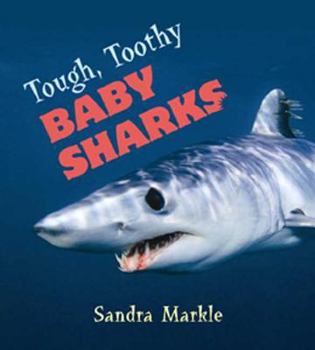Tough, Toothy Baby Sharks
Select Format
Select Condition 
Book Overview
Even before they're born, baby sharks have to be tough to survive. Some that grow inside their mothers compete with their womb-mates for food, space, and their very lives. Others have to escape as soon as their mothers give birth to avoid becoming her tasty snack. If they survive those rough beginnings, baby sharks then have to figure out how to make it in an ocean teeming with predators. Brilliant color photographs reveal how shark pups grow from tiny eggs into giant eating machines, reaching the top of the food chain in all the world's oceans. Science expert Sandra Markle's introduction to baby sharks provides rare glimpses of these creatures at their most vulnerable and will captivate young fans of nature's toughest creatures.
Format:Hardcover
Language:English
ISBN:0802795935
ISBN13:9780802795939
Release Date:October 2007
Publisher:Walker Childrens
Length:32 Pages
Weight:0.75 lbs.
Dimensions:9.8" x 0.4" x 9.6"
Age Range:5 to 8 years
Grade Range:Grades 4 to 7
Customer Reviews
1 rating
Oh, the Shark Bites, with Its Teeth, Dear
Published by Thriftbooks.com User , 16 years ago
An excellent survey of various types of baby sharks, this book explores shark development from conception through embryonic development, birth, young pup life, and growth into maturity. Because of language level (as well as certain graphic content, it's probably most appropriate for the older elementary school student. Also, parents senstive to sex-education in school (if that's where this book is read) or even at home should be aware that this is a science book. Reproduction is described using accurate terms, presented in a dispassionate, factual manner. We learn that while most bony fish males release their sperm over hatched eggs; sharks, such as the Port Jackson shark directly contact the female shark. Describing a (somewhat unclear) photograph, Markle writes: "The male is biting the female to hold onto her. He has a stiff, grooved, tubelike extension on each of his two pelvic fins. Inserting one or the other of these, he desposits his sperm into her reproductive tract." Sharks differ in their in utero development, and the author does an excellent job explaining differences in gestational period, feeding, and wieght and size on birth. THere's are a lot of fascinating facts; for example, the Sandtiger pups hatch inside their mother, and the bigger pups begin eating both unfertilized eggs and their recently hatched, smaller siblings until only two survivors (onefor each of the shark;s two uteri) are released. Other pregnancy and birth examples are less gruesome. The high quality color photographs add a lot of interest, but they also don't always clearly display what the text is describing. A few more diagrams/drawings would have been helpful. Markle concludes with a map showing the home grounds of the various sharks she discusses, a pleaaa for shark conservation, some very interesting shark tidbits under the heading "Sharks are Cool!," and a glossary/index. This award winning author and TV/Internet science program developer has constructed a serious but entertaining book for budding marine biologists. 32 pages including credits and acknowledgments to two experts in the field.






